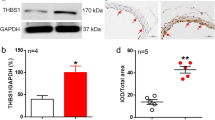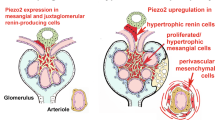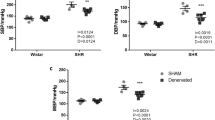Abstract
Aim:
To investigate the effects of selective knockdown of TRPV1 channels in the lower thoracic and upper lumbar segments of spinal cord, dorsal root ganglia (DRG) and mesenteric arteries on rat blood pressure responses to high salt intake.
Methods:
TRPV1 short-hairpin RNA (shRNA) was delivered using intrathecal injection (6 μg·kg−1·d−1, for 3 d). Levels of TRPV1 and tyrosine hydroxylase expression were determined by Western blot analysis. Systolic blood pressure and mean arterial pressure (MAP) were examined using tail-cuff and direct arterial measurement, respectively.
Results:
In rats injected with control shRNA, high-salt diet (HS) caused higher systolic blood pressure compared with normal-salt diet (NS) (HS:149±4 mmHg; NS:126±2 mmHg, P<0.05). Intrathecal injection of TRPV1 shRNA significantly increased the systolic blood pressure in both HS rats and NS rats (HS:169±3 mmHg; NS:139±2 mmHg). The increases was greater in HS rats than in NS rats (HS: 13.9%±1.8%; NS: 9.8±0.7, P<0.05). After TRPV1 shRNA treatment, TRPV1 expression in the dorsal horn and DRG of T8-L3 segments and in mesenteric arteries was knocked down to a greater extent in HS rats compared with NS rats. Blockade of α1-adrenoceptors abolished the TRPV1 shRNA-induced pressor effects. In rats injected with TRPV1 shRNA, level of tyrosine hydroxylase in mesenteric arteries was increased to a greater extent in HS rats compared with NS rats.
Conclusion:
Selective knockdown of TRPV1 expression in the lower thoracic and upper lumbar segments of spinal cord, DRG, and mesenteric arteries enhanced the prohypertensive effects of high salt intake, suggesting that TRPV1 channels in these sites protect against increased salt sensitivity, possibly via suppression of sympatho-excitatory responses.
Similar content being viewed by others
Log in or create a free account to read this content
Gain free access to this article, as well as selected content from this journal and more on nature.com
or
References
Zygmunt PM, Petersson J, Andersson DA, Chuang H, Sorgard M, Di Marzo V, et al. Vanilloid receptors on sensory nerves mediate the vasodilator action of anandamide. Nature 1999; 400: 452–7.
Zahner MR, Li DP, Chen SR, Pan HL . Cardiac vanilloid receptor 1-expressing afferent nerves and their role in the cardiogenic sympathetic reflex in rats. J Physiol 2003; 551: 515–23.
Kopp UC, Jones SY, DiBona GF . Afferent renal denervation impairs baroreflex control of efferent renal sympathetic nerve activity. Am J Physiol Regul Integr Comp Physiol 2008; 295: R1882–90.
Caterina MJ, Schumacher MA, Tominaga M, Rosen TA, Levine JD, Julius D . The capsaicin receptor: a heat-activated ion channel in the pain pathway. Nature 1997; 389: 816–24.
Tominaga M, Caterina MJ, Malmberg AB, Rosen TA, Gilbert H, Skinner K, et al. The cloned capsaicin receptor integrates multiple pain-producing stimuli. Neuron 1998; 21: 531–43.
Wang DH, Li J, Qiu J . Salt-sensitive hypertension induced by sensory denervation: introduction of a new model. Hypertension 1998; 32: 649–53.
Wang DH, Li J . Antihypertensive mechanisms underlying a novel salt-sensitive hypertensive model induced by sensory denervation. Hypertension 1999; 33: 499–503.
Huang Y, Wang DH . Role of AT1 and AT2 receptor subtypes in salt-sensitive hypertension induced by sensory nerve degeneration. J Hypertens 2001; 19: 1841–6.
Huang Y, Wang DH . Role of renin-angiotensin-aldosterone system in salt-sensitive hypertension induced by sensory denervation. Am J Physiol Heart Circ Physiol 2001; 281: H2143–9.
Wang DH, Wu W, Lookingland KJ . Degeneration of capsaicin-sensitive sensory nerves leads to increased salt sensitivity through enhancement of sympathoexcitatory response. Hypertension 2001; 37: 440–3.
Ye DZ, Wang DH . Function and regulation of endothelin-1 and its receptors in salt sensitive hypertension induced by sensory nerve degeneration. Hypertension 2002; 39: 673–8.
Wang Y, Chen AF, Wang DH . ETA receptor blockade prevents renal dysfunction in salt-sensitive hypertension induced by sensory denervation. Am J Physiol Heart Circ Physiol 2005; 289: H2005–11.
Song WZ, Chen AF, Wang DH . Increased salt sensitivity induced by sensory denervation: role of superoxide. Acta Pharmacol Sin 2004; 25: 1626–32.
Wang Y, Chen AF, Wang DH . Enhanced oxidative stress in kidneys of salt-sensitive hypertension: role of sensory nerves. Am J Physiol Heart Circ Physiol 2006; 291: H3136–43.
Li J, Wang DH . Function and regulation of epithelial sodium transporters in the kidney of a salt-sensitive hypertensive rat model. J Hypertens 2007; 25: 1065–72.
Vaishnava P, Wang DH . Capsaicin sensitive-sensory nerves and blood pressure regulation. Curr Med Chem Cardiovasc Hematol Agents 2003; 1: 177–88.
Wang DH . The vanilloid receptor and hypertension. Acta Pharmacol Sin 2005; 26: 286–94.
Wang Y, Wang DH . Neural control of blood pressure: focusing on capsaicin-sensitive sensory nerves. Cardiovasc Hematol Disord Drug Targets 2007; 7: 37–46.
Wang DH . Transient receptor potential vanilloid channels in hypertension, inflammation, and end organ damage: an imminent target of therapy for cardiovascular disease? Curr Opin Cardiol 2008; 23: 356–63.
Rayamajhi S, Contractor T, Wang DH . The potential of TRPV1 agonists for treating ischemia/reperfusion-induced renal injuries. Curr Opin Investig Drugs 2009; 10: 963–70.
Kobayashi K, Fukuoka T, Obata K, Yamanaka H, Dai Y, Tokunaga A, et al. Distinct expression of TRPM8, TRPA1, and TRPV1 mRNAs in rat primary afferent neurons with adelta/c-fibers and colocalization with trk receptors. J Comp Neurol 2005; 493: 596–606.
Price TJ, Flores CM . Critical evaluation of the colocalization between calcitonin gene-related peptide, substance P, transient receptor potential vanilloid subfamily type 1 immunoreactivities, and isolectin B4 binding in primary afferent neurons of the rat and mouse. J Pain 2007; 8: 263–72.
Gao F, Sui D, Garavito RM, Worden RM, Wang DH . Salt intake augments hypotensive effects of transient receptor potential vanilloid 4: functional significance and implication. Hypertension 2009; 53: 228–35.
Kawasaki H, Takasaki K, Saito A, Goto K . Calcitonin gene-related peptide acts as a novel vasodilator neurotransmitter in mesenteric resistance vessels of the rat. Nature 1988; 335: 164–7.
Mayer G . An update on the relationship between the kidney, salt and hypertension. Wien Med Wochenschr 2008; 158: 365–9.
Ciriello J, Calaresu FR . Central projections of afferent renal fibers in the rat: an anterograde transport study of horseradish peroxidase. J Auton Nerv Syst 1983; 8: 273–85.
Donovan MK, Wyss JM, Winternitz SR . Localization of renal sensory neurons using the fluorescent dye technique. Brain Res 1983; 259: 119–22.
Chevendra V, Weaver LC . Distribution of splenic, mesenteric and renal neurons in sympathetic ganglia in rats. J Auton Nerv Syst 1991; 33: 47–53.
Huang J, Chowhdury SI, Weiss ML . Distribution of sympathetic preganglionic neurons innervating the kidney in the rat: PRV transneuronal tracing and serial reconstruction. Auton Neurosci 2002; 95: 57–70.
Zou W, Song Z, Guo Q, Liu C, Zhang Z, Zhang Y . Intrathecal lentiviral-mediated RNA interference targeting PKCγ attenuates chronic constriction injury-induced neuropathic pain in rats. Hum Gene Ther 2011; 22: 465–75.
Vizzard MA, Standish A, Ammons WS . Renal afferent input to ventrolateral medulla of the cat. Am J Physiol 1992; 263: R412–22.
Solano-Flores LP, Rosa-Arellano MP, Ciriello J . Fos induction in central structures after afferent renal stimulation. Brain Res 1997; 753: 102–19.
Bard P . Anatomical organization of the central nervous system in relation to control of the heart and blood vessels. Physiol Rev Suppl 1960; 4: 3–26.
Barman SM, Gebber GL . Brain stem neuronal types with activity patterns related to sympathetic nerve discharge. Am J Physiol 1981; 240: R335–47.
Wang LH, Luo M, Wang Y, Galligan JJ, Wang DH . Impaired vasodilation in response to perivascular nerve stimulation in mesenteric arteries of TRPV1-null mutant mice. J Hypertens 2006; 24: 2399–408.
Wang Y, Wang DH . Increased depressor response to N-arachidonoyl-dopamine during high salt intake: role of the TRPV1 receptor. J Hypertens 2007; 25: 2426–33.
Li J, Wang DH . Function and regulation of the vanilloid receptor in rats fed a high salt diet. J Hypertens 2003; 21: 1525–30.
Wang Y, Kaminski NE, Wang DH . VR1-mediated depressor effects during high-salt intake: role of anandamide. Hypertension 2005; 46: 986–91.
Wang Y, Novotny M, Quaiserová-Mocko V, Swain GM, Wang DH . TRPV1-mediated protection against endotoxin-induced hypotension and mortality in rats. Am J Physiol Regul Integr Comp Physiol 2008; 294: R1517–23.
Wang Y, Wang DH . A novel mechanism contributing to development of Dahl salt-sensitive hypertension: role of the transient receptor potential vanilloid type 1. Hypertension 2006; 47: 609–14.
Wang DH, Zhao Y . Increased salt sensitivity induced by impairment of sensory nerves: is nephropathy the cause? J Hypertens 2003; 21: 403–9.
Li J, Wang DH . High-salt-induced increase in blood pressure: role of capsaicin-sensitive sensory nerves. J Hypertens 2003; 21: 577–82.
Wang Y, Kaminski NE, Wang DH . Endocannabinoid regulates blood pressure via activation of the transient receptor potential vanilloid type 1 in Wistar rats fed a high-salt diet. J Pharmacol Exp Ther 2007; 321: 763–9.
Acknowledgements
This work was supported in part by the NIH (grants HL-57853, HL-73287, and DK67620).
Author information
Authors and Affiliations
Corresponding author
Rights and permissions
About this article
Cite this article
Yu, Sq., Wang, D. Enhanced salt sensitivity following shRNA silencing of neuronal TRPV1 in rat spinal cord. Acta Pharmacol Sin 32, 845–852 (2011). https://doi.org/10.1038/aps.2011.43
Received:
Accepted:
Published:
Issue date:
DOI: https://doi.org/10.1038/aps.2011.43
Keywords
This article is cited by
-
Selective ablation of TRPV1 by intrathecal injection of resiniferatoxin in rats increases renal sympathoexcitatory responses and salt sensitivity
Hypertension Research (2018)
-
Channelopathies and drug discovery in the postgenomic era
Acta Pharmacologica Sinica (2011)



